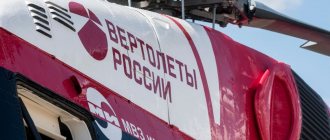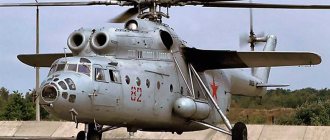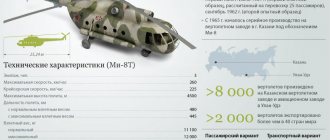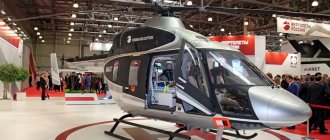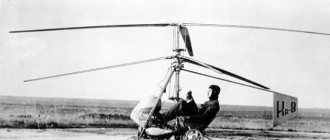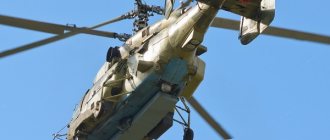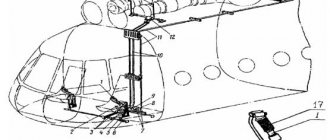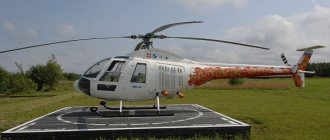| JSC National Center for Helicopter Engineering named after M. L. Mil and N. I. Kamov | |
| Type | Joint-Stock Company |
| Exchange listing | MCX: MVZM |
| Year of foundation | 1947 |
| Closing year | 2020 |
| Founders | Mil, Mikhail Leontievich |
| Location | Russia: Tomilino town, Moscow region |
| Industry | Mechanical engineering |
| Products | Helicopters |
| Equity |
|
| Turnover | ▼ RUB 2.638 billion (2010)[1] |
| Operating profit |
|
| Net profit | ▲ RUB 921.7 million (2010)[1] |
| Number of employees | 3246 (2015) |
| Parent company | Russian helicopters |
| Website | rhc.aero/structure/nhc |
| Media files on Wikimedia Commons | |
The National Helicopter Manufacturing Center named after M. L. Mil and N. I. Kamov
is an enterprise of the Russian aviation industry, located in the urban-type village of Tomilino, Lyubertsy district (Moscow region). Engaged in the development and trial operation of helicopters.
The center was created in December 2022 by merging two main helicopter development enterprises in Russia: JSC Moscow Helicopter Plant named after M. L. Mil and JSC Kamov[3][4].
It is part of Russian Helicopters JSC.
JSC "Moscow Helicopter Plant named after M. L. Mil"
| External images | |
| Moscow Helicopter Plant named after mile | |
| Moscow Helicopter Plant named after Mile (Lyubertsy). December 2015. | |
| |
Moscow Helicopter Plant named after M. L. Mil
- an aviation enterprise, initially located in the city of Moscow, in Sokolniki, later at a production base in the village of Tomilino, Lyubertsy district, Moscow region, developer and experienced operator of the Mi line of helicopters.
Story
In 1943, the territory of the former plant No. 388, created in 1941 on the basis of furniture factory No. 4 in Sokolniki, on Second Rybinskaya Street, for the production of airborne transport gliders, was transferred to plant No. 381 as branch No. 1. In 1946, it became the production base of the helicopter OKB-3, which was headed by I.P. Bratukhin. In 1948, OKB-3 was reorganized into the State Union Plant No. 3 with KB-1 (I.P. Bratukhin) and KB-2 (N.I. Kamov). In 1950, production of Mi-1 helicopters began there.
In 1951, M.L. Mil's Design Bureau No. 4 was transferred to this plant from Plant No. 82 in Tushino, and in 1953 the plant was renamed State Union Plant No. 329.
In 1960, the plant was allocated territory for the construction of a new production complex at the Panki station near Lyubertsy. The first buildings were built in 1963.
The plant became an experimental plant, and mass serial production of helicopters was launched at other enterprises.
In 1967, plant No. 329 was renamed the Moscow Helicopter Plant (MVZ). In 1970, after the death of Mikhail Mil, the Moscow Helicopter Plant and the Design Bureau were named after him.
In 1993, the plant was transformed into a joint-stock company, which in 2007 became part of the Russian Helicopters holding company of the Russian Technologies State Corporation (now Rostec)[5][6].
Personalities
The Moscow Helicopter Plant named after M. L. Mil was named in honor of Mikhail Leontievich Mil, a Soviet helicopter designer and scientist, Doctor of Technical Sciences (1945), Hero of Socialist Labor (1966), laureate of the Lenin Prize (1958) and the USSR State Prize (1968) .
In 2000-2001, the position of commercial director of OJSC "MVZ" was held by Denis Manturov, now the head of the Ministry of Industry and Trade of Russia.
Products
More than 15 basic models of helicopters, produced in more than 200 modifications, were designed and built at the Moscow Helicopter Plant.
Monument to the Mi-8 on the territory of the National Helicopter Engineering Center named after M. L. Mil and N. I. Kamov in Tomilino, Moscow Region
- Mi-1 "Moskvich" - multi-purpose helicopter;
- Mi-2 - light multi-purpose helicopter;
- Mi-4 is a medium multi-purpose helicopter, the first military transport helicopter of the USSR Armed Forces;
- Mi-6 - heavy airborne transport helicopter;
- B-7 - an experimental prototype of a helicopter with a jet engine;
- Mi-8 is a medium multi-purpose helicopter (the series includes the Mi-171), the most popular twin-engine helicopter in the world;
- Mi-10 - crane helicopter;
- B-12 is the heaviest and most load-lifting helicopter in the world;
- Mi-14 - multi-purpose amphibious helicopter;
- Mi-24 - transport and combat helicopter;
- Mi-26 is a multi-purpose heavy transport helicopter;
- Mi-28N - attack helicopter;
- Mi-34 - light training and sports helicopter;
- Mi-35M - attack helicopter;
- Mi-38 is a medium multi-purpose helicopter.
In philately
- Russian postage stamps: Mi helicopters
- Mi-1
- Mi-4
- Mi-8
- Mi-28
- Mi-34
Description of design
The two-story fuselage of the Mi-4 helicopter is built on the basis of a metal frame made up of frames and stringers. A metal sheathing of variable thickness is riveted on top. Structurally, the fuselage is divided into a main section and two beams - tail and end. Connections are detachable.
The engine load frame is attached to the first frame of the main section. Inside the main section of the Mi-4 vehicle there is a crew cabin, a cargo compartment and separate rooms for installing tanks, a main rotor gearbox and radio equipment.
The cargo compartment of the Mi-4 is equipped with loading doors located in the rear section. The width of the opening corresponds to the size of the compartment, which allows you to place large cargo and some types of cars and motorcycles (GAZ-69 all-terrain vehicle or a pair of M-72 motorcycles with side trailers).
The maximum volume of cargo transported by the machine is 16 cubic meters. m.
Additionally, there is a side door and three side windows. The cargo version was equipped with a manual winch and rigging devices. The transport version of the Mi-4 is equipped with removable seats designed to transport 12 people (overload up to 16). The ambulance is equipped with attachment points for 8 stretchers and an additional seat for an attendant.
A gondola is installed under the floor of the cargo compartment, which serves as a location for batteries and antennas. It is allowed to operate the helicopter with the nacelle removed and a protective sheet installed in place.
Two Mi-4 crew workstations with duplicate controls are located above the cargo compartment. The cockpit has an increased glass area and sliding side doors. The doors have blister-shaped glass to improve visibility. From the cabin you can enter the cargo compartment through a hatch in the floor. The hatch is equipped with a folding ladder.
The pilot's workplace is equipped with an oxygen device. The ambulances have eight portable oxygen devices, depending on the number of wounded or sick people being transported. To heat the cabin and cargo compartment of the Mi-4, a gasoline heater equipped with a network of air ducts is used. Additional members can be added to the crew of the vehicle - a navigator, a mechanic, an operator of additional equipment. In this case, one of the workplaces is equipped in a gondola.
The power plant on the Mi-4 vehicles is a 14-cylinder two-row “star” ASh-82N with carburetor power.
The engine is equipped with a release clutch and an axial fan for cooling the cylinders. Part of the air flow is diverted through channels to cool the oil radiators and gearbox housing. Air is supplied through the side air intakes.
Hot air is exhausted through grilles and controlled flaps on the hood of the machine. The Mi-4 engine is equipped with a two-speed mechanical supercharger, allowing it to develop 1,700 hp on takeoff. An exhaust system with free flow of gases was used, as well as an option with flame arresters.
The crankshaft of the Mi-4 engine is connected to the gearbox by a special shaft equipped with torsional vibration dampers. The shaft has a spline connection that compensates for changes in the installation points of the units. There is a clutch at the gearbox input that allows the screw to operate in free rotation mode.
The gearbox provides power take-off to drive the helicopter hydraulic oil pumps. A shaft is routed from the gearbox to the tail rotor drive. The drive has an additional gear that provides a change in the angle of the shafts (arising from the layout of the machine).
The main rotor of the Mi-4 helicopter has four blades of trapezoidal cross-section.
The blade profile is variable. The design of the power set is combined, consisting of wooden ribs and stringers fixed to the steel pipe of the spar. The blade covering is made of canvas and plywood. Later, machines began to use an all-metal propeller with a honeycomb filling, which had an increased service life.
The pushing tail rotor has three blades equipped with a pitch adjustment mechanism. The design of the regulator allows for reverse thrust. The blades are made of wood and have a metal frame.
The fuel supply on Mi-4 vehicles (grade B95/130 gasoline) is located in a single soft, protected tank with a capacity of 1000 liters, located behind the gearbox. The fuel is supplied by a pump; an additional electric valve is installed, which serves to dilute the oil in winter.
In the cargo compartment of the Mi-4 there is a standard place for installing a standard barrel with a capacity of 275 liters. The barrel is connected to the fuel supply line through a separate pump. As fuel is consumed, the tank is filled with inert gas. Additionally, the transmission includes a brake mechanism that locks the screws when the engine starts.
The Mi-4 helicopter uses a four-post fixed landing gear, which provides taxiing capabilities. The front rotary struts of the machine are mounted on the frame of the power unit, equipped with gas-oil shock absorbers and pneumatic tires measuring 400*150 mm. The wheels turn spontaneously, there is no forced control.
Braking mechanisms are not used.
The main racks with an extended track are equipped with pneumatic tires of size 700*250 mm and brakes with pneumatic drive. The design of the Mi-4 rack contains shock absorbers and tanks for storing compressed gas reserves. Additionally, the machine has a tail support that protects the helicopter from damage during rough landings. The support has a gas-oil shock absorber.
The electrical equipment of the Mi-4 helicopter is built using a single-wire circuit with the negative pole supplied to the body. DC sources with a voltage of 28 volts are the GSR-3000M generator located on the engine and batteries. Electricity distribution is carried out by three panels, the circuits are protected by bimetallic circuit breakers.
The standard equipment of the vehicle includes a radio station, a radio compass, a radio altimeter and an internal intercom.
To combat ice on Mi-4 vehicles, a special liquid (a mixture of alcohol and glycerin) is supplied to the blades and windshields of the cockpit. The liquid supply is in a special tank with a capacity of 28 liters.
JSC "Kamov" (Ukhtomsk Helicopter Plant)
Main article: Kamov (design bureau)
JSC "Kamov"
(formerly
Kamov OKB
,
Ukhtomsky Helicopter Plant
) is a design bureau of the Russian Helicopters holding company that existed until 2022. It was part of the Rostec state corporation. Known as a developer of helicopters with coaxial rotors. It also developed a helicopter with a traditional layout (Ka-62).
The OKB was named after its first general designer N.I. Kamov. The founding date is considered to be October 7, 1948. Open joint stock company since 1992.
Until 2022, it was located in the city of Lyubertsy (not far from the Ukhtomskaya railway station), later transferred to the building of the National Helicopter Manufacturing Center in the working village of Tomilino (not far from the Panki railway station).
Since 1972, the People's Museum of History and Labor Glory of Kamov OJSC has operated on the territory of the enterprise[7].
In December 2022, the OKB was abolished[3][4]. JSC Kamov was merged with JSC Moscow Helicopter Plant named after M. L. Mil, which was renamed JSC National Center for Helicopter Manufacturing named after M. L. Mil and N. I. Kamov.
Helicopters of OKB "Kamova"
| date | Model | NATO classification | A comment |
| September 25, 1929 | KaSkr-1 "Red Engineer", KaSkr-2 | Soviet gyroplane, Kamov - Skrzhinsky | |
| 1934 | A-7 | gyroplane | |
| 1944 | Ka-8 | ||
| September 1949 | Ka-10 | 'Hat' | |
| 1952 | Ka-15 | 'Hen' | |
| 1955 | Ka-18 | 'Hog' | |
| 1960 | Ka-20 | 'Harp' | |
| 1960 | Ka-22 | 'Hoop' | rotorcraft |
| 1965 | Ka-25 | 'Hormone' | |
| 1966 | Ka-26 | 'Hoodlum-A' | |
| 1969 | B-50 | the project was curtailed | |
| 1978 | Ka-27 and Ka-27PS (search and rescue) | 'Helix' | |
| 1981 | Ka-28 Ka-32 | 'Helix' | |
| July 27, 1982 | Ka-50 "Black Shark" (also known as B-80 and "Werewolf") | 'Hokum-A' | Ka-50-2 Erdogan |
| 1983 | Ka-52 "Alligator" | 'Hokum-B' | |
| 1983 | Ka-31 | 'Helix-B' | Helicopter AWACS |
| 1984 | Ka-29 | Development of the Ka-27 | |
| 1986 | Ka-126 | 'Hoodlum-B' | Development of the Ka-26 |
| mid 1980s | V-100 | ||
| 1990 | Ka-118 | ||
| 1993 | Ka-128 | ||
| 1993 | Ka-37 | unmanned helicopter | |
| 2016 | Ka-62 | ||
| 1994 | Ka-226 | 'Hoodlum' | Further development of the Ka-126 |
| 1998 | Ka-60 "Killer whale" |
- Kamov coaxial scheme (using the example of the Ka-25)
- Rotorcraft Ka-22
- Ka-27
- Ka-50 "Black Shark"
- Ka-52 "Alligator"
- Ka-60
- Ka-226
- Model of the Ka-92 high-speed helicopter being developed by the enterprise
Characteristics of the Mi-8
A country:USSRType:Multi-role helicopterYear of issue:1961Crew:2-3 people + 28 passengersEngine:2x TV2-117A, 1500 hp each.Maximum speed:250 km/hPractical ceiling:Static: 1300 m, dynamic: 4200 m.Range of flight:425 kmEmpty weight:7000 kgMaximum take-off weight:12000 kg (normal takeoff 11570 kg)Wingspan:Main rotor diameter: 21.288 m.Length:Fuselage: 18.168 m, total length with propellers: 25.24 mHeight:To the main rotor hub: 4.38 m, along the tail rotor: 5.65 m.Wing area:—Weapons:Not available in passenger version
Characteristics are given for the Mi-8P model
Notes
- ↑ 12
Company's annual report for 2010 (inaccessible link) - ↑ 12
https://www.kartoteka.ru/card/2b7d24e54ac7730883b49f6bab4f4f3c/ - ↑ 1 2
The Mil and Kamov design bureaus will be merged into the National Helicopter Manufacturing Center
(unspecified)
. www.russianhelicopters.aero. Date accessed: January 5, 2020. - ↑ 12
The merger of the Mil and Kamov helicopter plants was approved by the shareholders (Russian). Interfax-Russia.ru (December 23, 2019). Date accessed: January 5, 2022. - Moscow Helicopter Plant named after. M. L. Mil. Dossier (undefined)
.
tass.ru.
_ Access date: October 31, 2022. - Plant No. 329 (unspecified)
.
testpilot.ru
. Access date: October 31, 2022. - https://prowars.ru/ALL_OUT/AiKOut09/UVZMuz/UVZMuz001.htm. People's Museum of History and Labor Glory JSC "Kamov"
